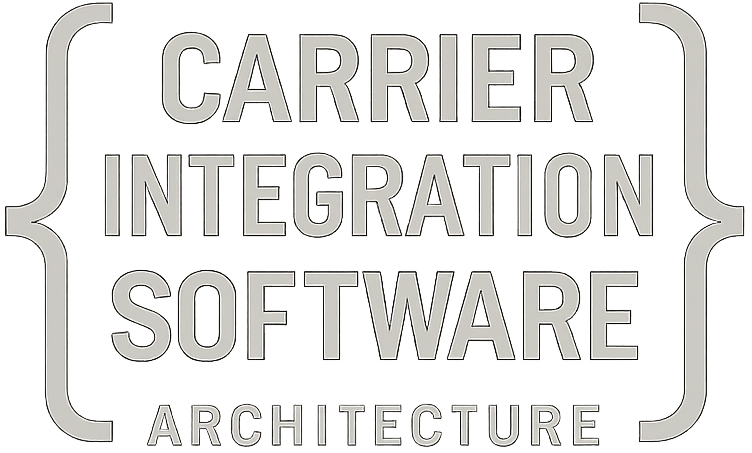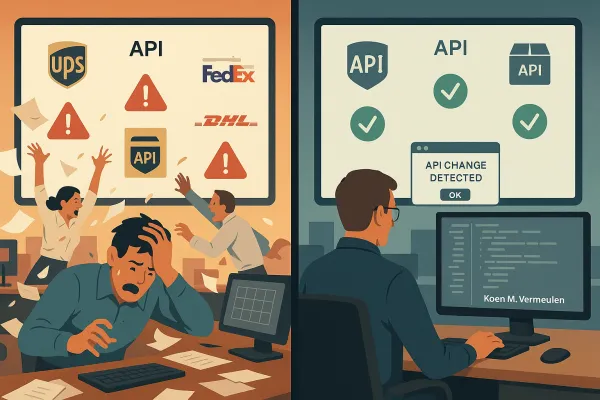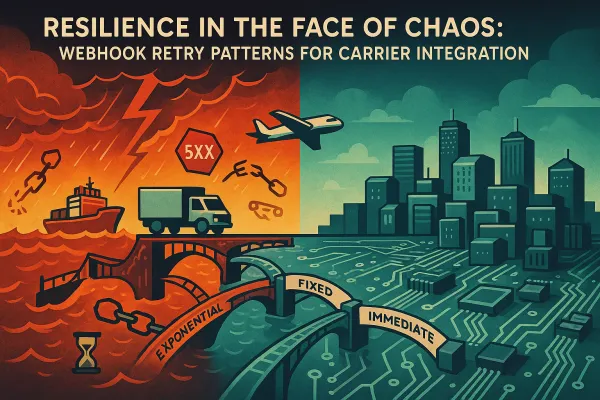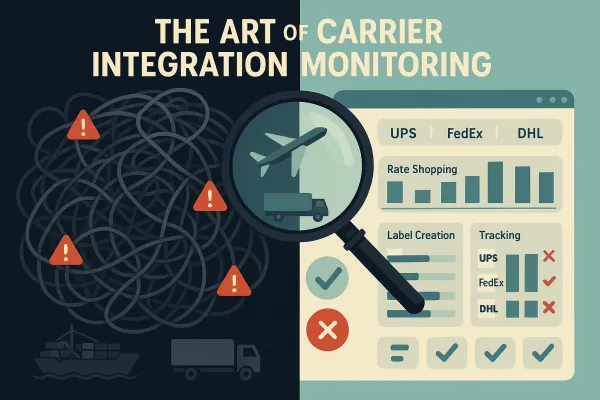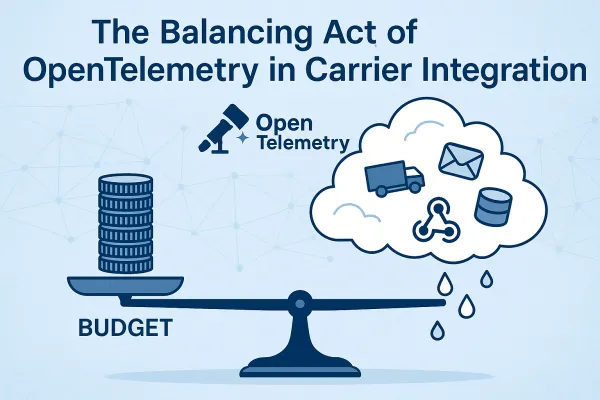Contract Testing for Carrier Integration: Managing API Versioning Without Breaking Consumer Contracts

Carrier APIs change without warning. You know this if you've ever woken up to broken rate requests or mysteriously failed label generation. Integration bugs discovered in production cost organizations an average of $8.2 million annually, while contract testing catches these issues early, reducing debugging time by up to 70%.
The problem isn't just technical debt. FedEx announced on August 18, 2022 that previous FedEx Web Services WSDLs are heading for retirement, with developers having until May 15, 2024 to adopt the improved FedEx API. UPS is replacing its entire existing API infrastructure, transitioning from access key-based authorization to OAuth 2.0, with post-June 3, 2024 transactions mandating this new security model.
Contract testing for carrier integration software provides a systematic approach to managing this chaos. Rather than discovering incompatibilities in production, you establish explicit agreements about what data formats, response codes, and behaviours to expect from each carrier API.
The Versioning Reality in Carrier Integration
Carrier APIs aren't just changing; they're evolving at different speeds with incompatible approaches. FedEx plans on releasing fewer major versions and deprecating a major version in two years from the release of newer major version - for example, if major version V2.0 is released in 2021, then V1.0 will be deprecated in 2023.
Meanwhile, the UPS transformation represents a complete architectural shift. UPS is transitioning to a true RESTful pattern, offering more flexibility, with any prior integrations requiring complete transformation to align with UPS's RESTful APIs from their new API Catalog.
Each change cascades through your integration layers. A field rename in tracking responses breaks parsing logic. Service level modifications affect rate shopping algorithms. Address validation schema updates impact label generation workflows. When these changes hit production without warning, API contract testing can reduce downtime caused by mismatches between API versions, providing peace of mind that services can integrate without issues during production releases.
The frequency makes manual testing impractical. Shippo's API changelog shows the pace: FedEx have retired their Collect on Delivery (COD) service for FedEx Express and FedEx Ground, meaning when you create a shipment and include the option for COD, the rates returned will not include rates from FedEx. Each modification requires regression testing across multiple consumer systems.
Contract Testing Fundamentals for Shipping APIs
Contract testing is a methodology for ensuring that two separate systems are compatible and can communicate with one other, capturing interactions that are exchanged between each service and storing them in a contract which can be used to verify that both parties adhere to it.
For carrier integration platforms, this translates to defining explicit expectations for rate requests, tracking webhooks, and label generation responses. Rather than assuming what a carrier API returns, you document the exact structure, validate against it, and catch deviations before they reach production.
The consumer-driven approach works particularly well here. The "consumer-driven" prefix simply states an additional philosophical position that advocates for better internal microservices design by putting the consumers of such APIs at the heart of the design process. Your TMS system defines what it needs from carrier APIs, then contract tests ensure those expectations remain valid as carriers evolve.
Consider a rate shopping contract. Your consumer expects specific fields in rate responses: service level, cost, transit time, and delivery date. When FedEx introduces new rate calculation logic or UPS modifies service codes, contract tests immediately flag compatibility issues rather than letting silent failures corrupt customer pricing.
Pact is a code-first tool for testing HTTP and message integrations using contract tests, with contract tests asserting that inter-application messages conform to a shared understanding documented in a contract. Tools like this generate contracts from actual API interactions, making maintenance manageable even with frequent carrier updates.
Designing Version-Aware Contract Schemas
Effective contracts anticipate change rather than assume stability. The envelope vs payload pattern proves particularly useful for carrier integration. Your contract validates the outer structure - response codes, headers, basic schema - while allowing carrier-specific payload evolution within defined boundaries.
Additive changes maintain backwards compatibility. When carriers add new tracking event types or introduce additional rate modifiers, well-designed contracts accommodate these extensions without breaking existing consumers. Minor versions support most new functionality and feature updates, with post major version 1.0 seeing minor versions 1.1, 1.2, etc. released to introduce new functionality.
Schema evolution requires deliberate choices. Optional fields allow carriers to introduce new capabilities without forcing immediate consumer updates. Required field additions trigger contract violations, forcing explicit migration decisions. This prevents the gradual degradation that leads to production surprises.
Address validation provides a concrete example. Your contract might specify required fields (street, city, postal_code) while marking enhanced geocoding fields as optional. When carriers improve their validation services, consumers can adopt new capabilities at their own pace without breaking existing integrations.
Versioning strategies matter. Rather than maintaining parallel API versions, consider feature toggles within contracts. Your rate request contract might include optional fields for advanced rating (dimensional weight, delivery options) while maintaining compatibility with basic implementations.
Consumer-Driven Testing for Multi-Tenant Platforms
In CDCT, the consumer creates the contract and shares it with the provider, ensuring that the provider delivers only the data the consumer needs and prevents over-engineering. For multi-tenant carrier middleware, this approach manages complexity across hundreds of shipper configurations.
Each tenant might use different carrier features. Tenant A needs basic ground shipping with USPS. Tenant B requires international shipping with customs documentation via FedEx and DHL. Tenant C processes high-volume ecommerce with rate shopping across multiple carriers. Consumer-driven contracts capture these specific requirements rather than testing everything against everyone.
Contract organisation follows tenant boundaries. Rather than monolithic carrier contracts, you maintain focused contracts per tenant-carrier combination. This granularity enables independent deployments and reduces testing overhead. When FedEx changes international documentation requirements, only affected tenant contracts require updates.
Consider platforms like Cargoson, nShift, or EasyPost managing thousands of shipper integrations. Consumer-driven contracts scale this complexity by letting each shipper define their specific carrier usage patterns. The platform validates these contracts against actual carrier APIs, catching incompatibilities before they affect live shipments.
Multi-tenant routing adds another dimension. Your contract might specify that Tenant A's ground shipments route through UPS while their overnight requests use FedEx. Contract tests verify both routing logic and individual carrier compatibility for each tenant's specific configuration.
Automated Contract Validation in CI/CD
To maximize benefits and allow systems to evolve gracefully, contract generation and validation should be tied to continuous integration, with consuming applications publishing new contracts while providing applications must ensure that updated code honors existing contracts with service consumers.
Pre-deployment validation prevents breaking changes from reaching production. Your CI pipeline runs contract tests against carrier sandbox environments before promoting code. When UPS modifies their OAuth token refresh mechanism or FedEx changes rate calculation logic, automated tests catch incompatibilities during development rather than during peak shipping hours.
By integrating contract tests into CI/CD pipelines, teams can automate the validation of API changes whenever code is pushed, ensuring that breaking changes are detected automatically before they impact production. This automation proves essential given the frequency of carrier API updates and the cost of production failures.
Contract publication follows deployment pipelines. Development contracts test against carrier sandbox environments. Staging contracts validate against carrier test systems with production-like data. Production contracts verify live carrier API compatibility. This progression catches environment-specific issues that single-stage testing might miss.
Tools like PactFlow provide contract brokers that manage this complexity. Publishers upload contracts from different environments. Consumers verify against specific contract versions. The broker tracks compatibility across deployment pipelines, enabling safe releases with confidence in carrier integration stability.
Webhook validation requires special attention. Carrier tracking webhooks often behave differently in sandbox vs production environments. Your contract tests should validate both webhook payload structure and delivery reliability, catching issues like missing signature validation or inconsistent retry behaviour.
Handling Breaking Changes Gracefully
The process of updating API contracts should be thoughtful, involving commitments to notify developers well in advance of changes, with modifications to API code requiring evaluation to ascertain whether updates affect existing consumers and if versioning is required.
Deprecation timelines provide migration windows. When carriers announce API changes, your contracts should reflect both current and future states during overlap periods. You will have to update the URI to the latest version within two years so FedEx can retire the older version. This timeline allows systematic migration rather than emergency fixes.
Parallel version support manages transition complexity. Your platform might simultaneously support UPS's legacy XML APIs and their new REST endpoints during migration periods. Contract tests verify both versions work correctly, enabling tenant-by-tenant migration based on their specific requirements and timelines.
Feature flags control rollout risk. New carrier API versions can be enabled for specific tenants while maintaining existing integrations for others. Contract tests validate both code paths, ensuring reliability during gradual migrations. This approach proved valuable during the UPS OAuth transition, allowing early adopters to test new authentication while maintaining stable service for other tenants.
Communication becomes part of your contract strategy. When contract tests detect breaking changes from carriers, automated alerts notify affected tenants with specific migration guidance. Rather than discovering issues through failed shipments, proactive communication enables planned updates.
Backward compatibility validation prevents regression. As you update contracts for new carrier API versions, automated tests ensure existing consumer integrations continue working. This dual validation - forward compatibility with new APIs and backward compatibility with existing consumers - maintains platform stability during transitions.
Monitoring and Observability for Contract Health
Contract testing generates valuable observability data beyond pass/fail results. Success rates across different carriers indicate API stability trends. Response time changes suggest carrier infrastructure modifications. Error patterns reveal emerging compatibility issues before they become widespread failures.
Correlation with production metrics provides context. When contract tests show increased FedEx API response times, correlating with actual shipping performance helps determine whether this affects customer experience. Similarly, contract validation failures that don't impact live shipments might indicate overly strict test conditions rather than real problems.
Carrier-specific dashboards track contract health per provider. UPS contract success rates, FedEx API response time trends, USPS webhook delivery reliability - these metrics help operations teams understand which carriers need attention and when proactive communication with customers becomes necessary.
Alert thresholds should balance noise with actionable information. Contract test failures for single tenants might indicate configuration issues. Widespread failures across multiple tenants suggest broader carrier API problems requiring immediate investigation and potentially customer communication.
Version adoption metrics guide deprecation decisions. When contract tests show most tenants successfully using new carrier API versions, you can confidently deprecate older integration paths. Conversely, slow adoption rates might indicate migration barriers that need addressing before forced updates.
Integration with distributed tracing connects contract test results with actual shipping workflows. When a contract test passes but production shipments fail, tracing helps identify gaps between test scenarios and real-world usage patterns.
The investment in comprehensive contract testing pays dividends during carrier API transitions. Rather than reactive firefighting when APIs change, you gain proactive visibility into compatibility issues and systematic approaches for managing complexity across multi-tenant carrier integration platforms.
Start with your highest-impact carrier integrations. Implement consumer-driven contracts for your most frequently used APIs - typically rate shopping and tracking. Expand coverage gradually, learning from early implementations before tackling more complex scenarios like international shipping or specialized carrier services.
